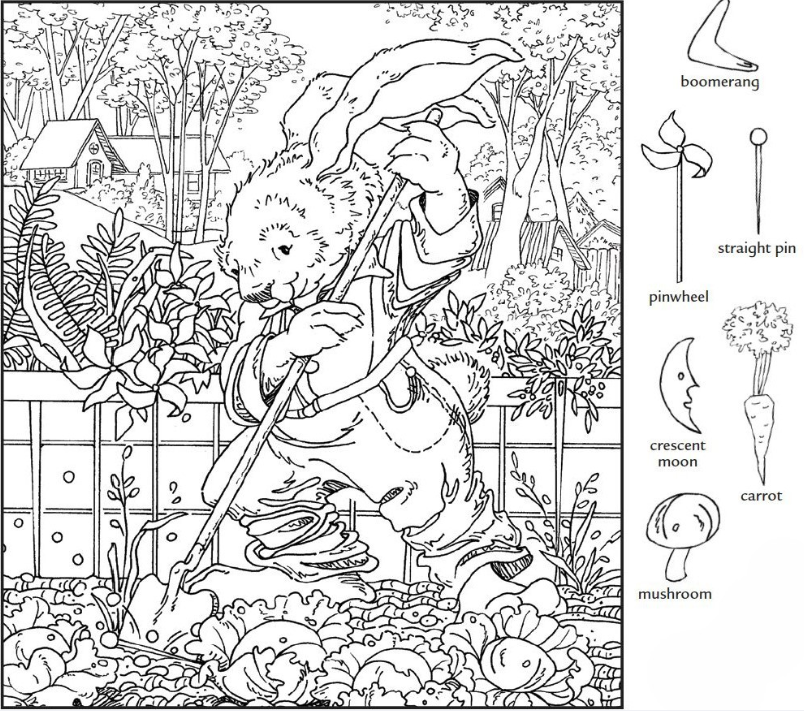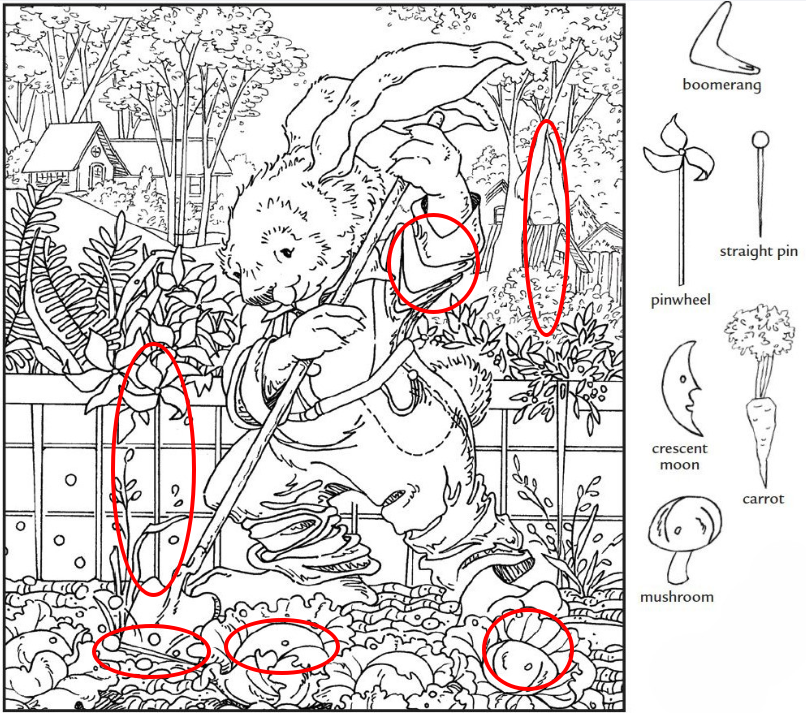The Gardening Rabbit: A Hidden Object Puzzle Full of Whimsy and Discovery
A Charming Scene with More Than Meets the Eye
At first glance, this illustration looks like a simple pastoral story. A rabbit dressed in overalls works diligently in a garden, hoe in hand, surrounded by rows of vegetables, leafy greens, and tall trees. But this isn’t just a cute picture—it’s a hidden object puzzle cleverly packed with surprises. Look closely, and you’ll notice that what appears to be an ordinary gardening scene is filled with disguised shapes, subtle details, and hidden figures that bring the image to life in unexpected ways.
This artwork invites us to slow down and pay attention, turning a peaceful farmyard scene into a delightful challenge for the eyes and the mind.

Why Hidden Object Puzzles Are So Engaging
There’s a reason hidden object puzzles continue to capture the imagination of children and adults alike. They aren’t just fun—they actively engage your brain, improve focus, and sharpen your sense of observation.
- They demand focus: You can’t rush through them—you must pause and observe carefully.
- They reward curiosity: Every hidden object you find feels like a tiny victory.
- They boost creativity: They encourage us to see beyond the obvious and look for patterns, shapes, and illusions we might otherwise miss.
When you dive into a scene like this, you’re not just spotting hidden items—you’re training your brain to see the world in new ways.
The Rabbit at the Heart of the Puzzle
The main character of the illustration is the gardening rabbit. With floppy ears tied back and overalls rolled at the ankles, it looks almost human-like in its posture. But pay attention to the details of its clothing and fur—some of the folds, lines, and shadows may actually form hidden animals or objects.
The hoe in its hand draws your eye to the soil, but don’t stop there. Even the tool itself could conceal shapes worked cleverly into its design. The artist has hidden surprises in unexpected places, encouraging you to look twice at what seems ordinary.

The Vegetable Patch Below
The garden rows are bursting with cabbages and other leafy greens. At first glance, they look like standard vegetables. But hidden object puzzles often use repeating shapes—like leaves and soil mounds—to camouflage animals, insects, or symbols. Could that cabbage leaf also be the wing of a butterfly? Could a round vegetable double as a hidden egg?
The soil, too, holds secrets. The curves and bumps may hide small creatures—worms, bugs, or tiny rodents—blending naturally into the garden scene.
The Fence and the Foliage
The wooden fence in the background is more than just decoration. Look carefully at the lines, knots, and spaces between planks. Could they form letters, animals, or hidden faces? The plants climbing up the fence add another layer of camouflage. Leaves and vines are favorite spots for hidden details because their flowing shapes make perfect disguises.

The Forest Beyond the Garden
In the background, tall trees rise above the rabbit, and houses peek out between them. The bark and branches of the trees are especially important to scan. Often, faces, animals, or symbols are carved subtly into the textures of tree trunks. Clouds and foliage can also hold hidden patterns, adding to the challenge of spotting every detail.
Tips for Spotting Hidden Objects Quickly
If you’re eager to solve this puzzle, here are some strategies that will make the search easier and more enjoyable:
- Work in sections: Break the image into parts—foreground, background, and character—so you don’t miss anything.
- Look for oddities: If something looks slightly out of place, like a leaf that curves differently, it’s probably intentional.
- Check for symmetry: Human faces and animal shapes often emerge from mirrored or balanced lines.
- Step back: Sometimes the larger hidden forms are easier to see when you look at the whole picture rather than focusing too closely.

Why These Puzzles Are Perfect for All Ages
The magic of hidden object puzzles is that they appeal to everyone.
- For kids, they’re playful learning tools. Children develop patience, observation, and focus while exploring fun illustrations. They also expand their imagination—suddenly, a rabbit’s ear isn’t just an ear; it might be the outline of a bird in flight.
- For adults, these puzzles provide a welcome break from daily stress. They encourage mindfulness by pulling you into the present moment, while also keeping your brain sharp and engaged. Solving them is like exercising the mind while enjoying a whimsical story.
The Deeper Symbolism of the Gardening Rabbit
Beyond the puzzle itself, the rabbit as a character carries symbolic weight. Rabbits are often associated with growth, abundance, and nurturing. In this scene, the act of gardening mirrors the themes of patience and care—tending to the soil, planting seeds, and waiting for harvest. The hidden objects scattered throughout remind us that life, too, is full of unnoticed details waiting to be discovered.

Conclusion: A Garden Full of Secrets
This gardening rabbit illustration is more than a charming picture—it’s an immersive puzzle that combines whimsy with challenge. From the folds in the rabbit’s overalls to the rows of cabbages and the forest beyond, every corner of the image hides something new.
By taking the time to look closely, we not only uncover the hidden objects but also train ourselves to notice the little details in everyday life. After all, much like a garden, the joy of discovery lies not just in the harvest but in the careful attention we give along the way.